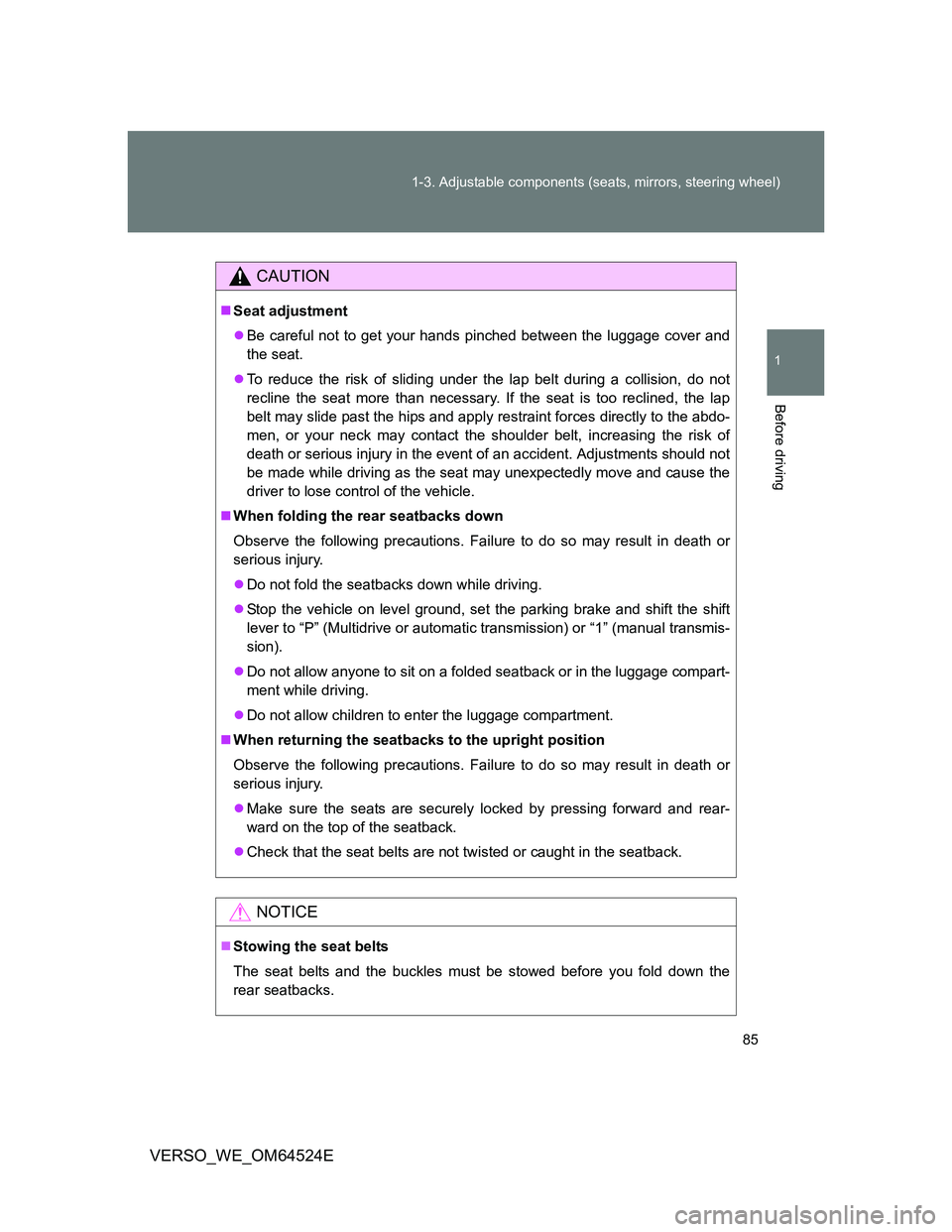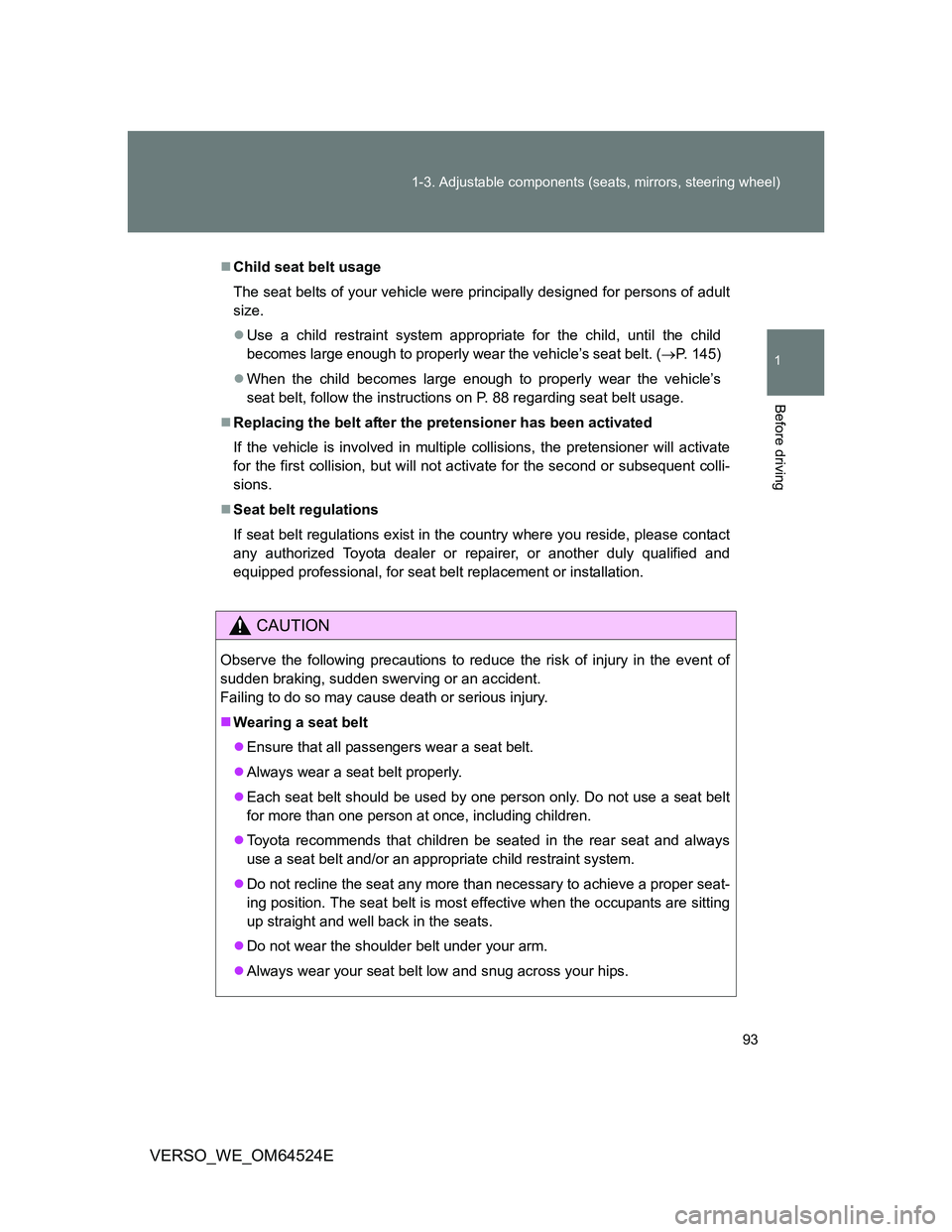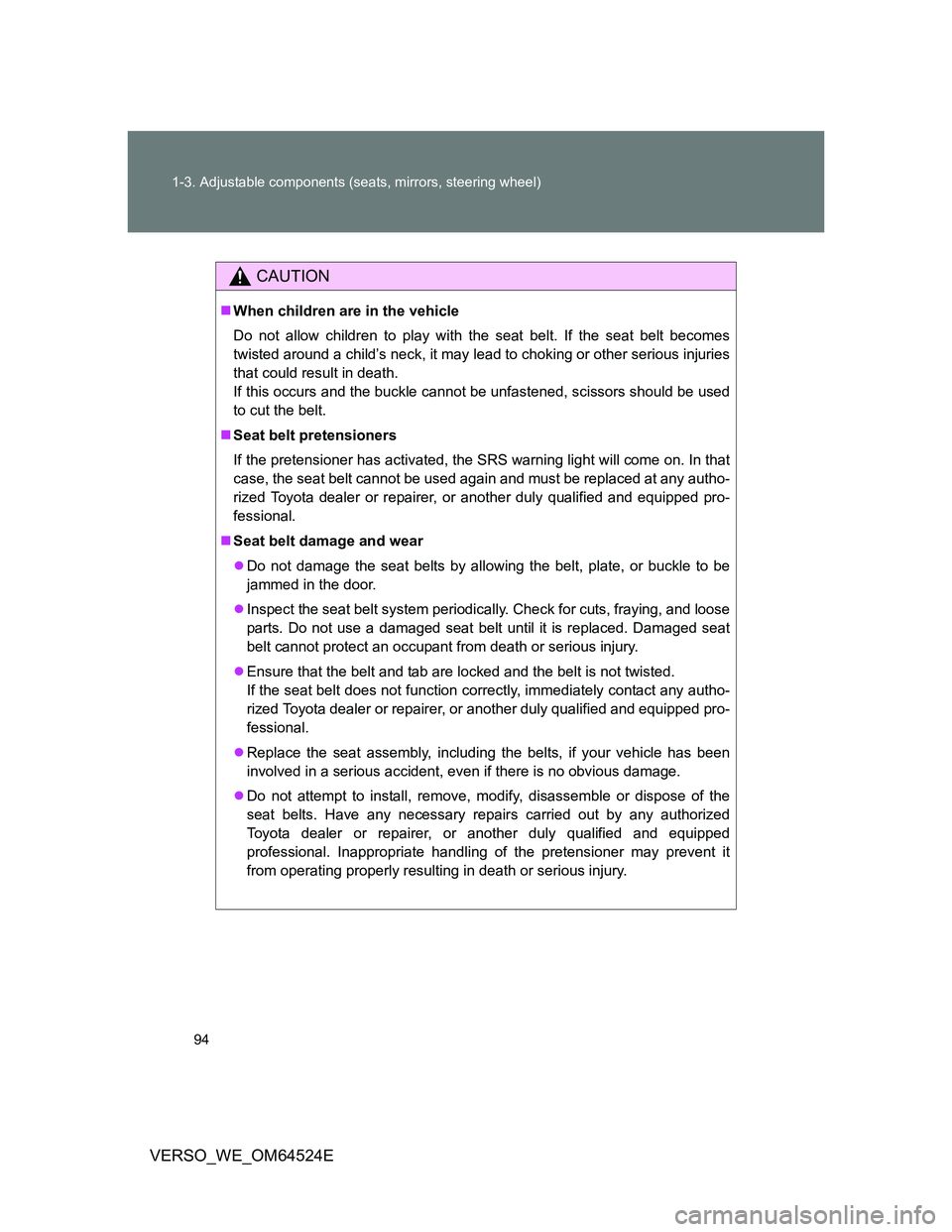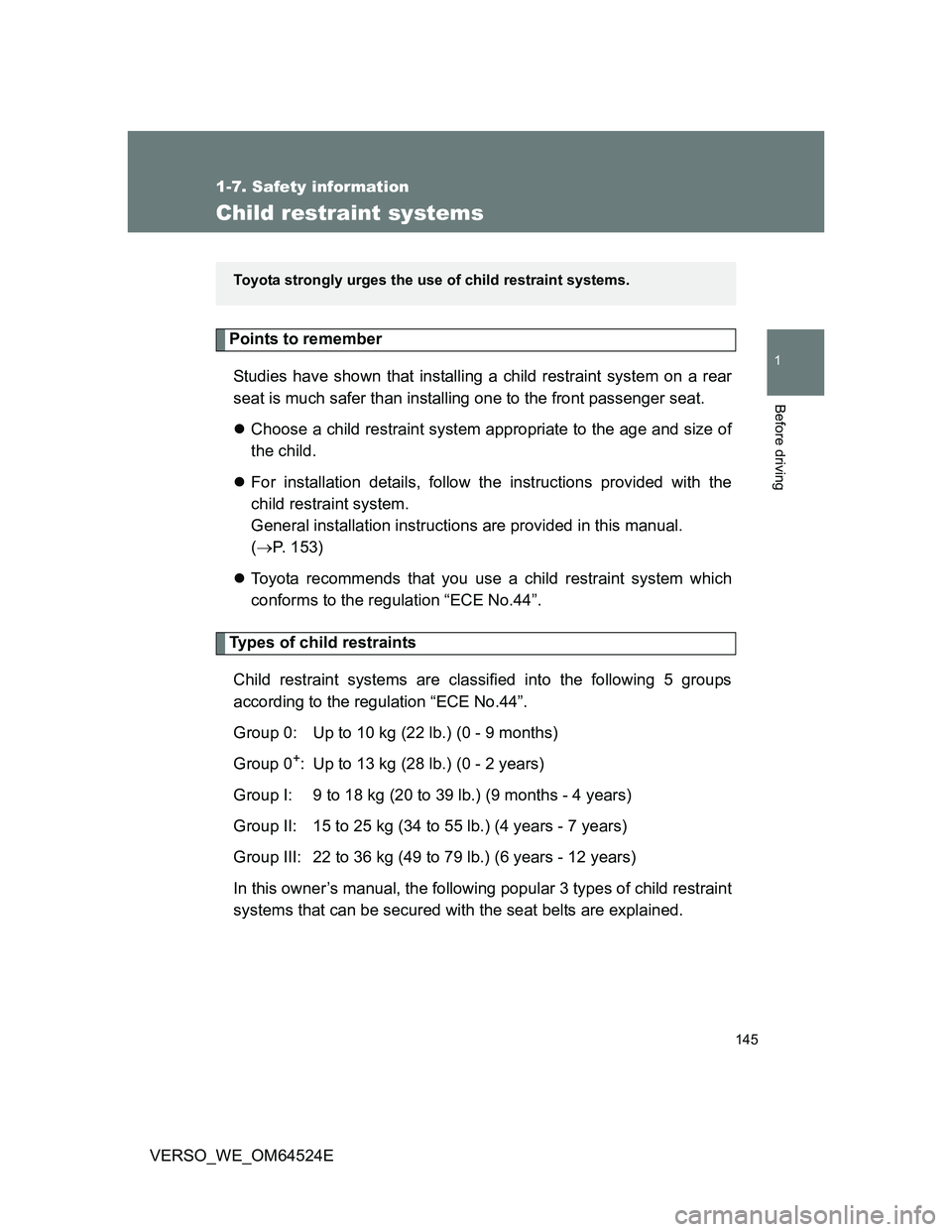2012 TOYOTA VERSO child seat
[x] Cancel search: child seatPage 2 of 588

TABLE OF CONTENTSIndex
2
VERSO_WE_OM64524E
1-1. Key information
Keys ...................................... 38
1-2. Opening, closing and locking
the doors
Smart entry & start system.. 41
Wireless remote control ........ 58
Side doors............................. 67
Back door.............................. 73
1-3. Adjustable components
(seats, mirrors, steering
wheel)
Front seats ............................ 77
Rear seats ............................ 79
Head restraints ..................... 86
Seat belts .............................. 88
Steering wheel ...................... 96
Inside rear view mirror .......... 97
Outside rear view mirrors.... 100
1-4. Opening and closing the win-
dows
Power windows ................... 102
1-5. Refueling
Opening the fuel tank cap ... 105
1-6. Theft deterrent system
Engine immobilizer system . 112
Double locking system...... 120
Alarm .................................. 1221-7. Safety information
Correct driving posture ....... 131
SRS airbags ....................... 133
Child restraint systems ....... 145
Installing child restraints ..... 153
Airbag manual on-off sys-
tem....................................167
2-1. Driving procedures
Driving the vehicle .............. 172
Engine (ignition) switch (vehicles
without smart entry & start sys-
tem) .................................. 186
Engine (ignition) switch (vehicles
with smart entry & start sys-
tem)....................................190
Multidrive* .......................... 196
Automatic transmission*..... 202
Manual transmission* ......... 209
Turn signal lever................. 213
Parking brake ..................... 214
Horn ................................... 216
2-2. Instrument cluster
Gauges and meters............ 217
Indicators and warning
lights.................................222
Multi-information display .... 226
2-3. Operating the lights and wip-
ers
Headlight switch ................. 239
Fog light switch .................. 244
1Before driving
2When driving
Page 37 of 588

1Before driving
37
VERSO_WE_OM64524E
1-1. Key information
Keys.................................... 38
1-2. Opening, closing and locking
the doors
Smart entry & start
system .............................. 41
Wireless remote control ...... 58
Side doors .......................... 67
Back door ........................... 73
1-3. Adjustable components
(seats, mirrors, steering
wheel)
Front seats.......................... 77
Rear seats .......................... 79
Head restraints ................... 86
Seat belts............................ 88
Steering wheel .................... 96
Inside rear view mirror ........ 97
Outside rear view
mirrors ............................ 100
1-4. Opening and closing
the windows
Power windows................. 102
1-5. Refueling
Opening the fuel tank
cap .................................. 1051-6. Theft deterrent system
Engine immobilizer
system ............................ 112
Double locking
system ............................ 120
Alarm ................................ 122
1-7. Safety information
Correct driving posture ..... 131
SRS airbags...................... 133
Child restraint systems ..... 145
Installing child restraints ... 153
Airbag manual on-off
system ............................ 167
Page 72 of 588

72 1-2. Opening, closing and locking the doors
VERSO_WE_OM64524E
Impact detection door lock release system
In the event that the vehicle is subject to a strong impact, all the doors are
unlocked. Depending on the force of the impact or the type of accident, how-
ever, the system may not operate.
Using the mechanical key (vehicles with smart entry & start system)
The doors can also be locked and unlocked with the mechanical key.
(P. 525)
CAUTION
To prevent an accident
Observe the following precautions while driving the vehicle.
Failing to do so may result in a door opening and an occupant falling out,
resulting in death or serious injury.
Always use a seat belt.
Ensure that all doors are properly closed.
Do not pull the inside handle of the doors while driving.
The doors may be opened and the passengers are thrown out of the vehi-
cle and it may result in serious injury or death.
Be especially careful for the driver’s door, as the door may be opened
even if the inside lock button is in locked position.
Set the rear door child-protector locks when children are seated in the rear
seat.
Page 85 of 588

85 1-3. Adjustable components (seats, mirrors, steering wheel)
1
Before driving
VERSO_WE_OM64524E
CAUTION
Seat adjustment
Be careful not to get your hands pinched between the luggage cover and
the seat.
To reduce the risk of sliding under the lap belt during a collision, do not
recline the seat more than necessary. If the seat is too reclined, the lap
belt may slide past the hips and apply restraint forces directly to the abdo-
men, or your neck may contact the shoulder belt, increasing the risk of
death or serious injury in the event of an accident. Adjustments should not
be made while driving as the seat may unexpectedly move and cause the
driver to lose control of the vehicle.
When folding the rear seatbacks down
Observe the following precautions. Failure to do so may result in death or
serious injury.
Do not fold the seatbacks down while driving.
Stop the vehicle on level ground, set the parking brake and shift the shift
lever to “P” (Multidrive or automatic transmission) or “1” (manual transmis-
sion).
Do not allow anyone to sit on a folded seatback or in the luggage compart-
ment while driving.
Do not allow children to enter the luggage compartment.
When returning the seatbacks to the upright position
Observe the following precautions. Failure to do so may result in death or
serious injury.
Make sure the seats are securely locked by pressing forward and rear-
ward on the top of the seatback.
Check that the seat belts are not twisted or caught in the seatback.
NOTICE
Stowing the seat belts
The seat belts and the buckles must be stowed before you fold down the
rear seatbacks.
Page 93 of 588

93 1-3. Adjustable components (seats, mirrors, steering wheel)
1
Before driving
VERSO_WE_OM64524E
Child seat belt usage
The seat belts of your vehicle were principally designed for persons of adult
size.
Use a child restraint system appropriate for the child, until the child
becomes large enough to properly wear the vehicle’s seat belt. (P. 145)
When the child becomes large enough to properly wear the vehicle’s
seat belt, follow the instructions on P. 88 regarding seat belt usage.
Replacing the belt after the pretensioner has been activated
If the vehicle is involved in multiple collisions, the pretensioner will activate
for the first collision, but will not activate for the second or subsequent colli-
sions.
Seat belt regulations
If seat belt regulations exist in the country where you reside, please contact
any authorized Toyota dealer or repairer, or another duly qualified and
equipped professional, for seat belt replacement or installation.
CAUTION
Observe the following precautions to reduce the risk of injury in the event of
sudden braking, sudden swerving or an accident.
Failing to do so may cause death or serious injury.
Wearing a seat belt
Ensure that all passengers wear a seat belt.
Always wear a seat belt properly.
Each seat belt should be used by one person only. Do not use a seat belt
for more than one person at once, including children.
Toyota recommends that children be seated in the rear seat and always
use a seat belt and/or an appropriate child restraint system.
Do not recline the seat any more than necessary to achieve a proper seat-
ing position. The seat belt is most effective when the occupants are sitting
up straight and well back in the seats.
Do not wear the shoulder belt under your arm.
Always wear your seat belt low and snug across your hips.
Page 94 of 588

94 1-3. Adjustable components (seats, mirrors, steering wheel)
VERSO_WE_OM64524E
CAUTION
When children are in the vehicle
Do not allow children to play with the seat belt. If the seat belt becomes
twisted around a child’s neck, it may lead to choking or other serious injuries
that could result in death.
If this occurs and the buckle cannot be unfastened, scissors should be used
to cut the belt.
Seat belt pretensioners
If the pretensioner has activated, the SRS warning light will come on. In that
case, the seat belt cannot be used again and must be replaced at any autho-
rized Toyota dealer or repairer, or another duly qualified and equipped pro-
fessional.
Seat belt damage and wear
Do not damage the seat belts by allowing the belt, plate, or buckle to be
jammed in the door.
Inspect the seat belt system periodically. Check for cuts, fraying, and loose
parts. Do not use a damaged seat belt until it is replaced. Damaged seat
belt cannot protect an occupant from death or serious injury.
Ensure that the belt and tab are locked and the belt is not twisted.
If the seat belt does not function correctly, immediately contact any autho-
rized Toyota dealer or repairer, or another duly qualified and equipped pro-
fessional.
Replace the seat assembly, including the belts, if your vehicle has been
involved in a serious accident, even if there is no obvious damage.
Do not attempt to install, remove, modify, disassemble or dispose of the
seat belts. Have any necessary repairs carried out by any authorized
Toyota dealer or repairer, or another duly qualified and equipped
professional. Inappropriate handling of the pretensioner may prevent it
from operating properly resulting in death or serious injury.
Page 141 of 588

141 1-7. Safety information
1
Before driving
VERSO_WE_OM64524E
CAUTION
SRS airbag precautions
The SRS front passenger airbag also deploys with considerable force, and
can cause death or serious injury especially if the front passenger is very
close to the airbag. The front passenger seat should be as far from the air-
bag as possible with the seatback adjusted, so the front passenger sits
upright.
Improperly seated and/or restrained infants and children can be killed or
seriously injured by a deploying airbag. An infant or child who is too small
to use a seat belt should be properly secured using a child restraint sys-
tem. Toyota strongly recommends that all infants and children be placed in
the rear seats of the vehicle and properly restrained. The rear seats are
the safest for infants and children. (P. 145)
Do not sit on the edge of the seat or
lean against the dashboard.
Do not allow a child to stand in front of
the SRS front passenger airbag unit or
sit on the knees of a front passenger.
Do not drive the vehicle while the driver
or passenger have items resting on
their knees.
Page 145 of 588

145
1
1-7. Safety information
Before driving
VERSO_WE_OM64524E
Child restraint systems
Points to remember
Studies have shown that installing a child restraint system on a rear
seat is much safer than installing one to the front passenger seat.
Choose a child restraint system appropriate to the age and size of
the child.
For installation details, follow the instructions provided with the
child restraint system.
General installation instructions are provided in this manual.
(P. 153)
Toyota recommends that you use a child restraint system which
conforms to the regulation “ECE No.44”.
Types of child restraints
Child restraint systems are classified into the following 5 groups
according to the regulation “ECE No.44”.
Group 0: Up to 10 kg (22 lb.) (0 - 9 months)
Group 0
+: Up to 13 kg (28 lb.) (0 - 2 years)
Group I: 9 to 18 kg (20 to 39 lb.) (9 months - 4 years)
Group II: 15 to 25 kg (34 to 55 lb.) (4 years - 7 years)
Group III: 22 to 36 kg (49 to 79 lb.) (6 years - 12 years)
In this owner’s manual, the following popular 3 types of child restraint
systems that can be secured with the seat belts are explained.
Toyota strongly urges the use of child restraint systems.